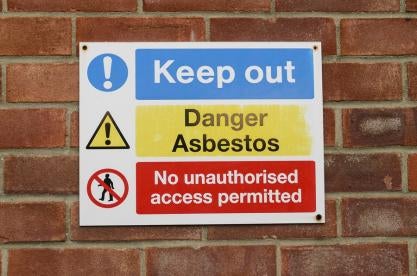On January 26, 2021, a coalition of advocacy groups and prominent asbestos plaintiffs’ experts launched two challenges to “Part 1” of the asbestos risk evaluation recently released by the United States Environmental Protection Agency (EPA). EPA concluded in Part 1 that 16 of the 32 “conditions of use” analyzed pose an “unreasonable risk” to human health, but advocacy groups have criticized EPA for only addressing risks associated with chrysotile asbestos and excluding review of other fiber types. Now, those groups have teamed up on a pair of legal challenges that could force EPA to revisit its Part 1 asbestos risk evaluation, which could delay risk management regulations.
First, the coalition filed a Petition for Review in the United States Court of Appeals for the Ninth Circuit seeking review of EPA’s conclusions about asbestos and the comprehensiveness of its analysis. One of the Petition’s chief complaints is that EPA “determin[ed] the risks of certain conditions of use of chrysotile asbestos fibers but declin[ed] to consider the risk of other asbestos fibers, conditions of use, health effects and pathways of exposure that impact public health.”
Second, the coalition issued a Notice of Intent to Sue (NOI) under the Toxic Substances Control Act (TSCA) § 20(a)(2). The NOI alleges that EPA failed to perform a non-discretionary duty because (1) it did not complete the entire asbestos risk evaluation by June 19, 2020; and (2) the final risk evaluation failed to address the use and disposal of “legacy” asbestos (uses of asbestos that are not “ongoing,” but may still pose a risk to consumers, such as asbestos in insulation).
While the coalition appears to have alleged valid grounds for lawsuits, it is not yet clear how these cases could change the playing field, as EPA already appears to be on its way to addressing existing legal deficiencies. The groups may be seeking a settlement with EPA or even an opportunity for EPA to request a remand of its Part 1 analysis. Notably, President Biden’s nominee for EPA Administrator, Michael Regan, acknowledged during his confirmation hearing on February 3 that he would “work with [his] staff to take a look at [the asbestos] evaluation, determine where those data and science gaps are, and govern ourselves accordingly.”
Implications
First, EPA is already conducting “Part 2” of its asbestos risk evaluation to address “legacy” asbestos in response to a previous court loss. A similar coalition of advocacy groups won their bid in the Ninth Circuit in November 2019 in which the court rejected EPA’s argument that it had the authority to omit legacy asbestos from the scope of review. See Safer Chemicals Healthy Families, et al. v. EPA, No. 17-72260 (9th Cir. Nov. 14, 2019). EPA obviously could not complete the legacy analysis by June 2020 just 7 months following the Ninth Circuit’s November 2019 order. However, the court’s intervening decision does not alleviate EPA from the statutory deadline, making the agency legally vulnerable to a mandatory duty suit. While EPA is already conducting the review, the coalition may be looking to force a settlement—EPA’s typical response when there is no legal defense. The groups may view this as more achievable with the new administration and as providing certainty on EPA’s timeline and court oversight to ensure against slippage.
Second, the issue to watch is what problems the groups will allege with the Part 1 evaluation and the progress of the litigation over the substance of the evaluation. Since Part 1 was completed in the prior administration, there is likely concern that allowing it to stand would leave in place a risk assessment that provides a less than desired foundation on which to craft risk management regulations. If the new administration chooses, it could even seek a voluntary remand of the action and merge Part 1 and Part 2. Additionally, legacy asbestos analysis has long been in the sights of advocacy groups and the deadline suit could provide an opportunity to have court oversight of the timeline for the legacy risk evaluation.
But, the challenges brought by the coalition, if EPA chooses to defend them, could create a paradox by potentially delaying asbestos regulations that the coalition likely believes are already long overdue. TSCA requires EPA to issue final regulations addressing the risks it identified in Part 1 of its risk evaluation within two years, and EPA is already beginning the risk management process. Favorable rulings in one or both of the cases could force EPA back to the drawing board on the asbestos risk evaluation, which could halt the asbestos regulations the Agency is already developing.
Next Steps
In the litigation already pending in the Ninth Circuit, the coalition must file its brief in support of its Petition by April 16, 2021. EPA will respond by May 17, 2021. The coalition cannot file their lawsuit (which must be brought in federal court) over the issues raised in the NOI until at least 60 days have passed following the NOI’s submission to EPA, or March 27, 2021.
These latest legal challenges add to the growing list of TSCA risk evaluation-related issues the Biden Administration has inherited and undertaken itself. Now, the Biden EPA will need to divert time and resources to legal challenges that will further burden the Agency, which is already spread thin on TSCA risk evaluation-related activities, including:
-
Addressing President Biden’s directive—issued on January 20, 2021, immediately after he took office—to review a number of actions the Agency had taken since 2017, including the overarching “Framework Rule” governing EPA’s risk evaluations (and on which the Agency had relied in excluding “legacy” uses from the original scope);
-
Analyzing legacy asbestos for “Part 2” of the asbestos risk evaluation;
-
Engaging in risk management activities and developing regulations to address the unreasonable risks found in the first 10 risk evaluations (including Part 1 of the asbestos risk evaluation), which had been expected to have been underway for at least six months, but are only now just beginning;
-
Conducting risk evaluations for the next 20 chemicals selected for analysis; and
-
Revising the Chemical Data Reporting (CDR) Rule to close “loopholes” regarding asbestos reporting to address a recent Northern District of California ruling that EPA, as a result, lacked sufficient information to conduct its asbestos risk evaluation.
Companies should keep a close eye on developments in both of these cases, which could have implications that extend more broadly than asbestos. Moreover, favorable rulings on the substance of EPA’s conclusions or procedures from either Court could provide useful precedent to others seeking to challenge EPA’s conclusions about other initial risk evaluations.







 i
i


